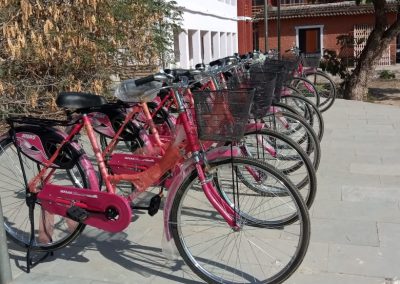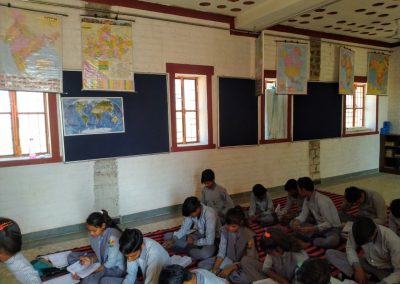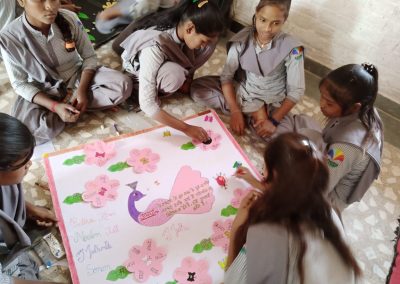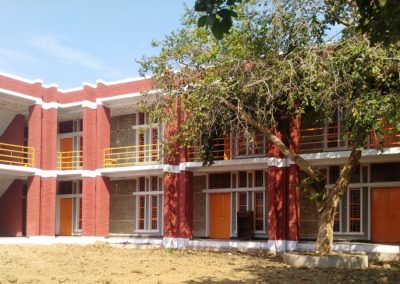Adharshila Higher Secondary School
The Adharshila Pedagogy
The first and foremost guiding principle for Adharshila is that it is for the children. The school is made to provide children a space where they can learn. It is not used to fulfil conscious/subconscious/suppressed desires, ambitions or egos of other stakeholders.
Learning, now, happens by questioning what we gather from our environment and attempting to get an answer from the information collected by our senses. The more senses a school allows its students to use, the better it is. This is facilitating learning. The more questions a child asks the more she learns. This is active learning. A school should have a blend of both. Children, we must understand, are not our projects. They are our extensions in time. We consider ourselves to be learned enough to be responsible for our actions, so do they. Aadharshila just provides a safe environment where they have enough opportunities to act responsibly and fail safely. It does not judge its children. There are no competitions, no winners. The children are encouraged to attend classes and take tests but there are no punishments if they chose not to.
Discipline
Discipline should come from within. It is not imposed, at Adharshila, for the sake of it. It is useful up to the point where it makes things easier for everybody. The school avoids punishing for undisciplined behaviour. Children are restless by nature and they are allowed to be so as long as they do not obstruct others. Like, they are not asked to fall in line and stand still where it can be avoided.
Student-teacher ratio.
A 25:1 ratio is a healthy one. However the school administration or administrative heads prefer to have a total strength that they can directly communicate with. Thus a 500-600 range is preferable. Adharshila avoids making multiple sections, shifts, or compartmentalising. Doing so alienates the students as well as the staff. Students and staff members have the school all for themselves the whole day.
Classrooms and teaching
Except for the very young children (up to grade V) the classrooms are not divided among grades. Rather, there are subject labs that have all the TLMs needed for classroom teaching. There are more than one teacher in each lab. Teachers plan and equip their rooms to facilitate all kinds of teaching and engage all senses.
Having such a structure also pre-empts the need of having a centralised library since all the books related to one subject are kept inside the labs and the class have reading periods in its timetable.
The teachers try and accommodate out of the class teaching sessions especially those that include the environs as TLMs.
Asking students to keep and carry books is avoided as far as possible. They are taught to refer to resources using other technologies at hand.
Similarly the number of subjects is kept as few as possible since learning is not as compartmentalised as perceived. Students are offered as many options within subjects as possible.
Timetable
Periodic bells are an absolutely unnecessary object. At Adharshila, there are clocks everywhere so that everyone knows the time. Going from one lab to another also gives the students much needed breaks between 2 classes. The school does not start very early in the morning since it is not good for the child to wake up very early and get on the feet quickly. It makes her irritable and alienates her.
Attendance
If a child is absent the school we talk to her first, to understand the reason. Mostly children find the school either boring or intimidating, none of which Adharshila should be. A child is never forced to come to the school or punished for being absent.
Decision making
All major decisions of Adharshila are taken jointly by the students and staff members where everyone has an equal vote. Apart from some specialised decisions or those related to the vision and mission of the organisation, the children can very well decide about their own activities. Again, the children decide the activity calendar of the school or exam dates and schedule. They also decide the MDM menu.
Extra-curricular activities
Adharshila does not pitch one student against other and rejoice on one’s defeat. Therefore we do not have competitions and instead have festivals where everyone gets the same prize for participation. Winning is a prize in itself.
Curriculum
The school follows the M.P. Board’s curriculum but does not stick to one set of books. Instead the teachers are encouraged to access as many diverse resources as possible to engage all the senses of their students. To enable this, the curriculum is first broken down into small parts each with one competency. In their lesson plans the teachers lay down methods to impart each competency.
Assessment
Written examinations (terminals and final) are part of assessment but not be considered sacrosanct. In fact assessment is continual and based on the competencies e.g. if the objective is to make a child understand the basic structure of a flower she is asked to identify the parts of a real flower or from a picture of it. Thus the test is an oral one.
The result of assessment is not be displayed publicly. There is absolutely no need to do so. The ranking system is also done away with.
Dress-code
The objective of a dress code is to make children dress soberly and not indulge into a competition of fashion. Making children look exactly similar serves no purpose. Thus the school has a dress code and gives away dresses every year but abstains from punishing those who, for some valid reason, cannot follow it.
Teacher student relation
At the best it is friendly and non-intimidating in the least. The teachers are encouraged to spend some time talking individually to the students. She is asked to not to talk down or engage in discriminating remarks like body shaming.
She is also trained to ask valid questions and make appropriate remarks. Like, saying ‘What have you done?’ to someone who has done a sum wrong is not a valid question.
She is trained to remember that anger arises out of fear and inefficiency of one who is angry and not the other. So getting angry on students is a problem and not a solution.
We keep in mind is that children learn more from examples than words. They watch us closely and imitate quickly. So either we practice what we preach or do not preach at all.
Administration
The role of administration is to facilitate and not govern nor punish. Even if it is forced to abandon some of its traditional roles the school administration considers itself only the custodian of the child and not her god.
Design and Access
The design and layout of the school is child friendly. Considering that children are restless and inquisitive, there are ample spaces to move and run. Decorative and breakable things are not placed within their reach. If fact the children are encouraged to be swift and noisy while outdoors.
All students have easy access to all places in the school including the office section. They know how to respect privacy and do not intrude. Administration avoids making out of bound areas. A garden is a very good example of this, we do not have one.
Address
Village: Agara, Tehsil: Vijaypur, Distt: Sheopur, Madhya Pradesh 476332
Phone
8602828192
96 91 62 33 09
admin[at]adharshila[dot]org[dot]in





